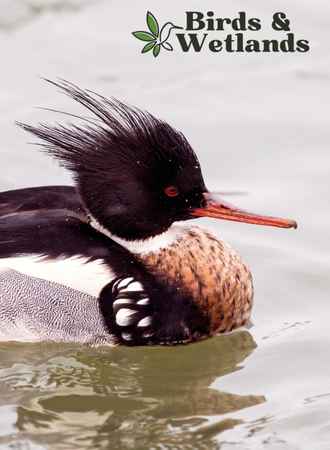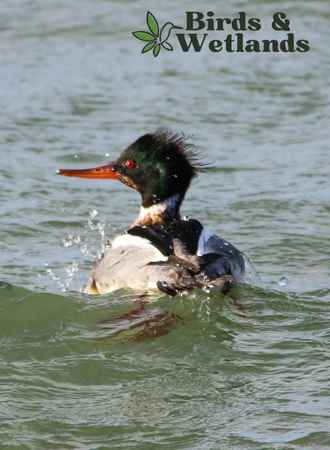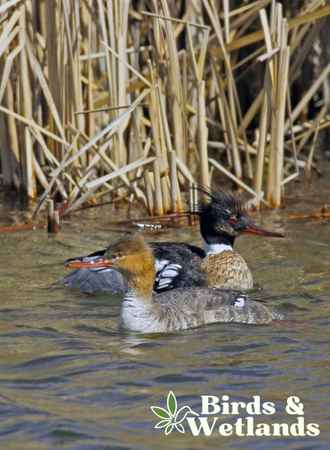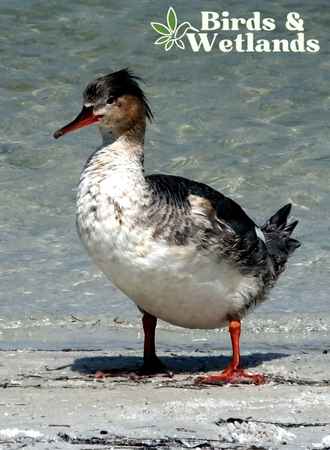The red-breasted merganser (Mergus serrator) is commonly found in coastal waters, rivers, and large lakes in North America, Europe, and Asia. It is often seen diving underwater to catch fish, which makes up most of its diet.
Scientific Name: Mergus serrator
Length: 51–62 cm (20–24 in)
Wingspan: 70–86 cm (28–34 in)
Average Weight: 28.2 to 47.6 oz (800 to 1,350 g)
Description
The adult male red-breasted merganser in breeding plumage has a distinctive appearance. It has a shaggy crest on top of its dark green head. It also has a rusty breast and thin bill with serrated edges, which the bird uses to eat and catch fish.
The adult female looks similar to the common merganser. She has a dull brown head and a gray body, while the female common merganser has a reddish-brown head. She also has a thinner bill.
Her eyes, legs, and feet are a duller red color, and she is generally smaller in size than the male.
Moreover, the female has a more subdued coloration than the male, which helps to camouflage her while she is nesting and caring for her young.

Listen to Red-Breasted Merganser
This bird is generally quiet but will make grunting notes during courtship.
Habitat & Range
The red-breasted merganser breeds in North America, Europe, and Asia. During the breeding season, they can be found in the northern parts of these regions, typically in the boreal forest near fresh, brackish, or saltwater wetlands.
After breeding, they migrate to other areas, where they can be found in oceans, freshwater lakes, and rivers.
In North America, this duck breeds farther north and winters farther south than other American merganser species. They migrate south to Florida and along the Gulf Coast in the winter months.
Small flocks of red-breasted mergansers use salt water wintering grounds, such as estuaries and coastal bays, more often than other merganser species.

Diet & Food Habits
The red-breasted merganser primarily feeds on fish, which they hunt by diving and swimming underwater.
In addition to small fish, red-breasted mergansers may also eat crustaceans, mollusks, and aquatic insects.

Nesting & Mating Habits
Red-breasted mergansers typically form breeding pairs in the late winter or late fall. Some pairs form in the early spring. Most pairs only last for the entire nesting season, with couples breaking up once all eggs are laid.
These ducks build their nests on the ground, near water. The nest is a simple depression lined with feathers and other soft materials to provide insulation and comfort for their eggs and chicks.
A female typically lays 6-12 eggs clutch and incubates them for 28 to 30 days. Shortly before the incubation period starts, the male leaves the female to join other males to molt.
After the eggs hatch, the female will lead the young ducks to the shallow water. She will molt with her young chicks after a few weeks.

Population & Conservation Status
The red-breasted merganser has a wide range and is currently listed as “Least Concern.” While the global population is stable, increasing threats such as predation, habitat loss, climate change and hunting pressure put these ducks at risk.
Hunting
Hunting red-breasted mergansers is allowed in certain parts of the United States. In most states where hunting is permitted, seasonal limits are placed on how many birds a hunter can take daily and within limits of the entire season.

Key Points
- Female red-breasted mergansers are smaller than the breeding males.
- Like other ducks, such as common mergansers, adult females build their nests near the water.
- Red-breasted mergansers primarily feed on aquatic animals.

